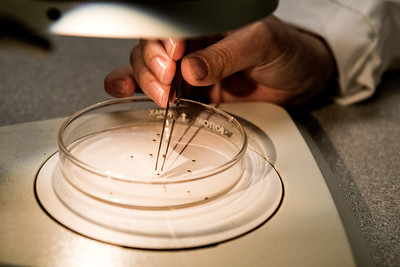By Fred Miller
U of A System Division of Agriculture
Editor’s note: This is the second in a series of three stories about research into the fascinating and agriculturally important world of bees. Today’s story focuses on a molecular survey of pathogens and parasites that pose threats to Arkansas’ managed honeybee populations.
Honeybee health is in decline in the United States and no single cause has been identified. Arkansas Agricultural Experiment Station researchers conducted a molecular survey of managed honeybee colonies in Arkansas to identify parasites and pathogens contributing to this decline in the state.
Allen Szalanski, professor of entomology and insect geneticist for the experiment station, the research arm of the University of Arkansas System Division of Agriculture, said Varroa destructor, a species of parasitic mites, was the top threat to Arkansas’ honeybees, based on the survey.
Threat detection
Szalanski said Dylan Cleary, a former Ph.D. student in his lab who graduated last year, led the survey.
While threats like the Varroa mite are well-known, Szalanski said, little research has been done to evaluate the risk that other parasites and pathogens pose to honeybees. Also, nationwide surveys of honeybee pests are not very detailed for individual states. “So, it’s important to do a state-based study,” he said.
In Cleary’s study, the researchers tested for a single-cell fungal parasite, a protozoan parasite called trypanosome and two bacterial pathogens known to invade bee populations in other areas of the country. Szalanski said knowing the presence or absence of these pests is critical to understanding invasive parasites and pathogens that may present future health threats to Arkansas honeybee colonies.
Szalanski said he and Cleary asked beekeepers registered with the Arkansas State Plant Board to collect and send in samples of bees from their colonies.
“We sampled 107 beekeepers around the state,” Szalanski said. “The participants submitted 541 samples from 47 counties.”
The State Plant Board has 3,849 registered beekeepers managing more than 61,000 honeybee colonies. Most Arkansas beekeepers keep “backyard” colonies that provide pollination services to their own or nearby farms, Szalanski said.
Test results
The researchers identified Varroa mites by separating the parasites from the bees and counting them. They submitted bees to DNA tests to identify the two fungal parasites and two bacterial pathogens. Varroa mites infected 41.1 percent of the samples, Szalanski said.
Varroa mites are tiny, button-shaped, no more than 2 millimeters wide and slightly shorter in length. They feed on fats sucked from honeybees’ bodies.
“The Varroa mite is like a vampire,” Szalanski said. “It feeds on both immature and adult bees.” The mite is also a carrier of honeybee viruses, he said.
While it’s virtually impossible to eliminate Varroa mites, Szalanski said beekeepers could control the parasite effectively with oxalic acid, a pest control in crystal form. “You heat up the crystals with an electric wand to fumigate the hive,” he said. The fumes kill about 70 percent of the mites without harming the bees.
A protozoan parasite called Nosema ceranae was found in 11.65 percent of the samples, followed closely by a trypanosome parasite, Lotmaria passim, in 11.28 percent of the bees.
“This is the first time we’ve seen Lotmaria passim in Arkansas,” Szalanski said.
None of the samples were positive for the bacterial pathogens for which they tested.
“It’s good to know what we have or don’t have in the state,” Szalanski said. “Even verifying that Varroa is widespread across Arkansas is important.”
Szalanski said that knowledge generated by this ongoing research could help Arkansas beekeepers make management decisions to protect the health of their colonies.
To learn more about Division of Agriculture research, visit the Arkansas Agricultural Experiment Station website: https://aaes.uada.edu/. Follow us on Twitter at @ArkAgResearch and on Instagram at @ArkAgResearch. To learn more about the Division of Agriculture, visit https://uada.edu/. Follow us on Twitter at @AgInArk.







